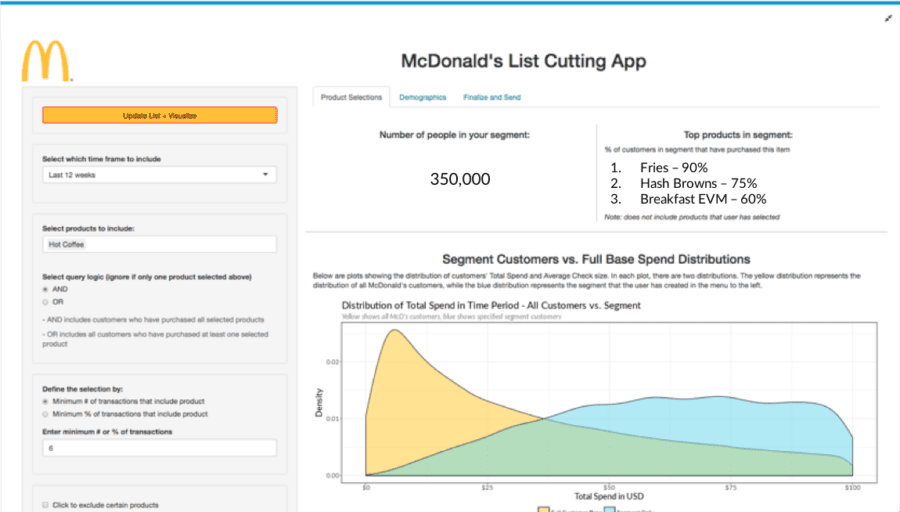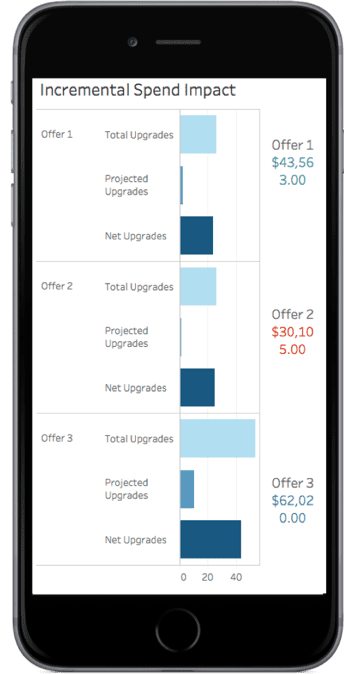Background: Civis began a data technology partnership with McDonald’s North America Marketing and Data Science teams in late 2017, and — after a year and a half of keeping our heads down — we jointly presented some of our key learnings recently at Advertising Week in New York.
David Galinsky, McDonald’s Director of Customer Data Science, and Emma Higgins, McDonald’s Media Sciences Manager, both represented McDonald’s, and I asked them questions about their experience, what we all learned, and what they’ve been able to return for the business. In case you want to nerd out, the full video of our conversation is here, and the short-cut video is here. We encourage it.
So what do we do together? Civis empowers the McDonald’s team with the Civis platform, a cloud-hosted data science stack for customer data science teams, but David and Emma’s teams produced the insights & implementation. The content below outlines our collective key steps in our journey, and lessons for other businesses.
McDonald’s is a $100B+ business in the midst of a digital transformation. In response to growing competition and changing consumer needs, McDonald’s has created a new (and now very popular) mobile application, and it’s redesigning many of its stores from the ground-up with digital kiosks. These new digital technologies are now creating a huge amount of rich customer data.
The question for McDonald’s, and every other business in a similar digital transformation, is how should marketers use these new data sources to improve marketing results?
In our Advertising Week conversation, David and Emma described how McDonald’s marketing operation has transformed itself from a traditional market-research led organization into an innovative digital first-party data & data science led organization. Today, McDonald’s leverages it’s 360-degree customer database to design, launch, and measure highly personalized campaigns that drive measurably stronger same-store sales. In a recent market experiment, for example, they found that a personalized marketing campaign’s impact on same-store-sales was 3–5x higher than a traditional marketing campaign’s impact. Those are big numbers.
Below, I’ve done my best to list the six lessons that David and Emma provided in our Advertising Week conversation. Again, dig into the video for the complete story, but these are the toplines:
1. As always, start with the data. Build a light-weight ‘single source of customer truth’ database in the cloud.
The first step is straightforward. The McDonald’s team first consolidated customer data from every relevant silo: in-store data, market research data, location data, their mobile application transaction data, and other sources, into a single database housed in the Civis Platform. Doing this in the cloud improved speed and let the IT team stay focused on core, production tech.
The next step is less straightforward: the McDonald’s team carefully and diligently created a single ‘customer ID,’ onto which they could show a person’s complete interaction with each part of McDonald’s — from market impression to purchase. Instead of data silos, they had a 360-degree view of each customer. This database allows McDonald’s to answer basic questions (who’s buying what?) and more complex cause-and-effect questions (who bought what after a new campaign?). It’s the fundamental anchor of the digital customer business.
2. Set the rules of success. Measure the impact of marketing activity against purchase behavior and deemphasize traditional marketing activity (e.g. ‘impressions’) metrics.
Once you have all of this data in one place, there’s an opportunity to move away from “impressions” and other vanity metrics that don’t accurately measure business value. We agreed early on that our KPIs would correlate with sales and in-store visits, something that was now possible with actual customer data. With the ability to conduct additional research nationally and among McDonald’s customers, we’ll also be able to measure changes in brand perception and attitudes.
3. Empower the marketing implementers with the data. Build web-based tools to empower the marketing & agency teams to cut their own lists based on first-party data. This replaces email back and forth and sleepless nights for the over-stretched data science teams.
McDonald’s wanted to target campaigns based on customers’ past purchases. The data science team had the ability to query the raw purchase data, but it created a bottleneck between who could generate lists and who was actually using them. David and Civis built a simple ‘list-cutting’ application in the Civis platform that enables marketers to pull lists directly from the customer database based on past purchases, and send that directly to their digital partners for activation. Below is an example of what they see (not real data).

4. Dashboards > PowerPoint. Build & deploy dashboards for leadership on key customer metrics and marketing performance that they can read on their phones. Down with slide decks!
It’s crucial to make this information accessible for leadership so that everyone feels comfortable relying on this single source of truth. Data scientists like David can produce Tableau reports through Platform for leadership to view. In fact, the President of McDonald’s US looks at Tableau reports like this on his phone (note: this is dummy data, not real data).

5. Test, learn, and scale as a team. Data science, marketing, and McDonald’s agencies should collectively design experiments to test personalization and scale the results at an enterprise level.
As mentioned above, McDonald’s tested a more personalized media experience based on first-party data-driven product segments. David and Emma set up a control group, who received a rotation of the usual McDonald’s media, and piloted a test where groups of customers received ads more tailored to their product preferences (“chicken people” see chicken ads, etc.). They saw a 3–5x increase in same-store sales among those who received targeted advertisements based on these new product segments. Better sales and customers receiving media that they like is a win-win.
6. Build support with advocates from day one, and drive institutional momentum with results.
One of the top takeaways from our conversation is the importance of having buy-in from cross-functional stakeholders right off the bat. McDonald’s’ “Measurement of the Future” team includes Marketing, Finance and IT, so data can serve as the guiding principle — and these stakeholders as the evangelists — across the organization. Everyone is using the same data, tools and building predictive models, which speeds up adoption and keeps momentum moving.
